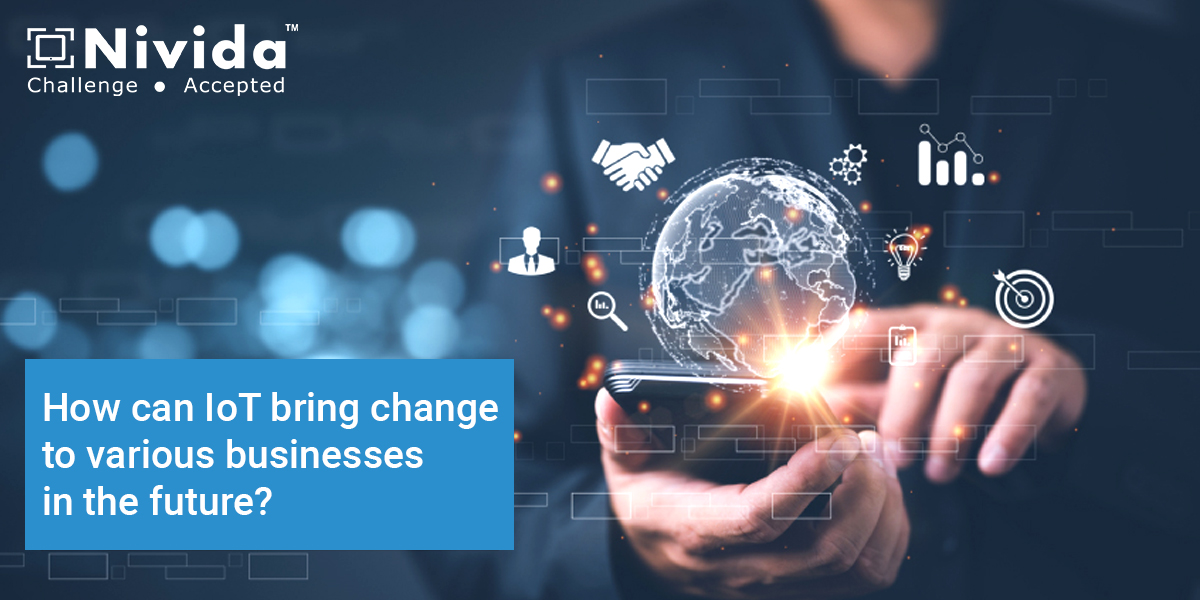Data is produced by nearly every facet of our life, and it is captured, shared, and monitored so that we can gain new understanding, increase productivity, and make better business decisions. Business owners and managers are just now beginning to appreciate IoT's potential benefits. Air track, doorbell cameras and security systems, thermostats, and many other IoT applications are being used in a wide variety of sectors, including energy, agriculture, healthcare, manufacturing, automotive, etc. The market for IIoT is expected to increase annually as more businesses use IoT technologies.
How can IoT bring change to various businesses in the future?
Industries such as logistics, aviation, manufacturing, transportation, oil and gas, mining, energy, etc., have been profoundly impacted by the Internet of Things. In fact, we are now in the midst of a fourth industrial revolution, which marks a qualitatively different epoch in the management and direction of the manufacturing sector. This new technological era is predicated on cyber-physical systems, often known as smart machines (Industry 4.0). It's also expected that by 2025, 94% of commercial enterprises would have used IoT.
Examining the applications of IIoT across industries:
- MANUFACTURING:
- TRANSPORTATION:
- UTILITY MANAGEMENT:
- HEALTHCARE:
- RETAIL:
- FINANCIAL SERVICES:
For manufacturers, there are two types of Internet of Things (IoT) investment:
INWARD FACING:
Machine efficiency and reducing production costs are primary concerns. Organizations prioritise internal investments in areas like process optimization, 24/7 equipment monitoring, and predictive and preventative maintenance using the Internet of Things (IoT).
OUTWARD FACING:
It seeks to enhance the user experience. In terms of customer-facing IoT applications, this involves keeping a network connection to services as well as products used by customers. In this method, producers examine findings and try to extrapolate general patterns from the obtained data about the product's application.
Many billions of dollars have been spent on Internet of Things (IoT) projects in the transportation sector. In fact, in 2016 alone, revenue from Fleet Management systems was $55.9 billion. Adding more sensors to automobiles can help with scheduling maintenance, optimising fuel use, ensuring driver safety, and monitoring the behaviour of driving concerning insurance. In the event of a severe collision, digital recorders are set to automatically record footage and upload it to the cloud when extreme acceleration is detected.
Utilities were early adopters of IoT investments. The United States as well as many of the European nations are major adopters of "smart grid" metres. In order to keep tabs on how many people are switching to renewable sources, these Smart Grid metres are vital. IoT devices are being adopted by the energy industry for asset monitoring, customer service improvement, and overall productivity enhancement.
IoT is also widely used in the oil and gas sector. This technology is used to examine the pressure, flow, etc., in a system with many pipes and valves scattered over wide areas. When any form of leak or obstruction occurs, the proper authorities are immediately notified.
The healthcare industry has a wide variety of potential applications for the Internet of Things and is predicted to have the fastest rate of expenditure growth in this area. The Internet of Things can be used for a wide variety of purposes, including but not limited to patient monitoring, real-time location tracking, equipment health analysis, and maintenance alerts.
Connecting pacemakers to the internet, for instance, can help patients by minimising errors and delivering accurate data as well as better diagnoses to doctors.
There have been enormous shifts in the retail sector in recent years. Who would have guessed that we could shop for goods from the comfort of our own homes? In the next years, it is expected that individuals will be able to virtually try on clothes from the comfort of their own homes utilising augmented reality and virtual reality headsets. Even more, there will be a plethora of inexpensive goods available. Internet of Things technology will be used in the production of these goods to ensure they are tailored to individual customer needs. In the long run, this will help us use less food and avoid hoarding too much of a single kind.
In order to ensure a safe and secure environment, the banking and financial industries rely significantly on distributed smart camera and sensor networks. Network expansion is a top priority for businesses in this industry. Customers, who are increasingly accustomed to handling all aspects of their financial dealings via a variety of connected devices, benefit from the enhanced security measures this entails.
Evidently, IoT has had an effect on every industry. By automating many of the sector's procedures, IoT can help it thrive and grow.

